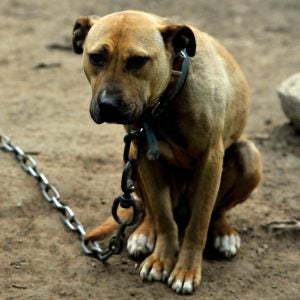
What is dogfighting?
Dogfighting is a sadistic “contest” in which two dogs—specifically bred, conditioned, and trained to fight—are placed in a “pit” to fight each other for the spectators’ entertainment and gambling.
Fights average one to two hours, ending when one of the dogs will not or cannot continue. In addition to these organized dogfights, street dogfights are a problem in many urban areas.
How does it cause animal suffering?
The injuries experienced by dogs participating in dogfights are frequently severe, even fatal. Both the winning and losing dogs can suffer severe bruising, deep puncture wounds, and broken bones. Dogs used in these events may die of blood loss, shock, dehydration, exhaustion, or infection hours or even days after the fight. Other animals are often sacrificed as well; dogs who are born “cold,” or won’t fight, are often killed (called culling in the dogfighting world) by brutal methods such as shooting, drowning, beating, electrocution, or even letting other dogs tear them apart.
Are there other concerns?
Yes. Numerous law enforcement raids in countries where it is illegal have unearthed many disturbing facets of this “sport.” Young children are sometimes present at the events, which can promote insensitivity to animal suffering, enthusiasm for violence, and disrespect for the law.
Gambling is the norm at dogfights. Dog owners and spectators wager money on their favorites.
Dogfighting is typically a cluster crime, meaning that dogfighters are often involved in other illicit activates. Illegal firearms, other weapons and drugs are commonly found at dogfights. Homicides and child pornography and abuse are not uncommon in dogfighting.
Why should dogfighters be strongly penalized?
Because dogfighting yields such large profits for participants, minor fines are not a sufficient deterrent. Dogfighters merely absorb them as part of the cost of doing business. The cruelty inherent in dogfighting should be punished by more than a slap on the wrist. Dogfighting is not a spur-of-the-moment act; it is a premeditated and cruel practice.
Those involved in dogfighting go to extensive lengths to avoid detection by law enforcement, so investigations can be difficult, dangerous, and expensive. Law enforcement officials are more inclined to investigate dogfighting if it is considered a serious offense. As more places make dogfighting a significant crime, those remaining locations with low penalties will become magnets for dogfighters.
In the United States, dogfighting is a felony offense in all 50 states, and it is a felony offense under federal law as well. It is banned to some extent in 55 countries around the world.
Should being a spectator also be a crime?
Yes. Spectators provide much of the profit associated with dogfighting. The money generated by admission fees and gambling helps keep this “sport” alive. Because dogfights are illegal and therefore not widely publicized, spectators do not merely happen upon a fight; they seek it out. They are willing participants who support a criminal activity through their paid admission and attendance.
What can I do to help stop dogfighting?
- Learn how to spot the signs of dogfighting.
- If you suspect dogfighting, alert your local law enforcement agency.
- In the United States and Costa Rica, urge officials to contact The HSUS and HSI for practical tools, advice and assistance. You may earn a reward for reporting via our tip lines.
- Live in the U.S.? Here’s more you can do.
